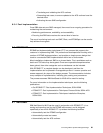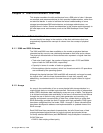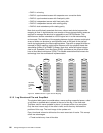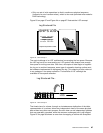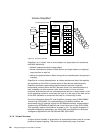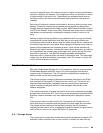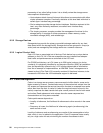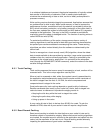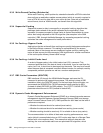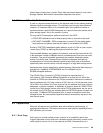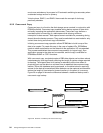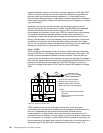
Disk Environment Overview 89
volumes
to physical disks. A functional volume is a logical volume still defined by
track size, capacity, and address. This mapping structure is contained in a series
of
tables stored in the control unit. These tables are updated at each write on
functional volume, and have to be maintained when previously used space is
released.
Data from all functional volumes could reside on one array device or many array
devices. Functional volumes can be defined and configured non-disruptively
through dynamic activation and utilities, such as
IBM Extended Facilities Product
(IXFP)
for the RAMAC Virtual Array (RVA). Because more arrays can be installed
and defined non-disruptively, increasing the capacity of such a control unit is
easy.
Defining a logical volume by tables brings capabilities such as easy and almost
instantaneous volume duplication when both source and target volumes are
controlled by the same set of tables inside the same storage server. However the
actual data copy has yet to take place. Either background storage server tasks or
system utilities implement the movement of data. Virtual volume definition by
tables brings another function: it allows the instant volume duplication by creating
two independent host access views of the same data, simply sharing the same
data with no replication. The IBM RVA SnapShot enables instantaneous
duplication with no physical space utilization at duplication time. This advantage
comes from the other architecture improvement, the LSF concept, on which the
virtual volume architecture is based.
9.2 Disk Control Units
DB2 uses VSAM Media Manager for its I/O operations. Like any access method,
VSAM Media Manager builds for every I/O a channel program and sends a
request to the I/O supervisor. The I/O supervisor enqueues this request on a
device number for the channel subsystem.
The channel program consists of standard commands, described in the ECKD
disk architecture, that specify I/O demand to the control unit. The control unit
executes these commands, propagates them and controls their requests to
logical volumes and physical devices. It also manages data delivery to the
channel subsystem.
The channel subsystem manages the transfer of channel commands and of data
through links to the control unit. This linking can be complex and involves ESCON
Directors, channel extenders, and even telecommunication devices for remote
I/Os.
There are two views of a disk control unit. Physically it is a
storage server to
which disk drives are attached and the channel links from hosts are connected.
The storage server contains all the facilities to perform the I/O operations.
Logically the disk control unit is an aggregate of subunits known as
logical control
units
(LCUs) or control unit images, doing the I/O operations.
9.2.1 Storage Server
The storage server contains all shared resources and processes to support LCU
activities. It often consists of two or more
clusters. A cluster can take over the



